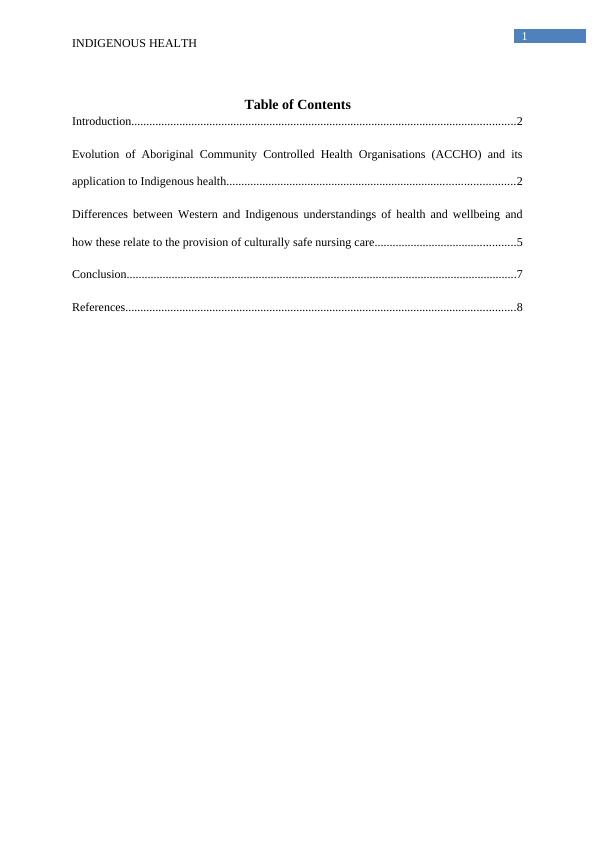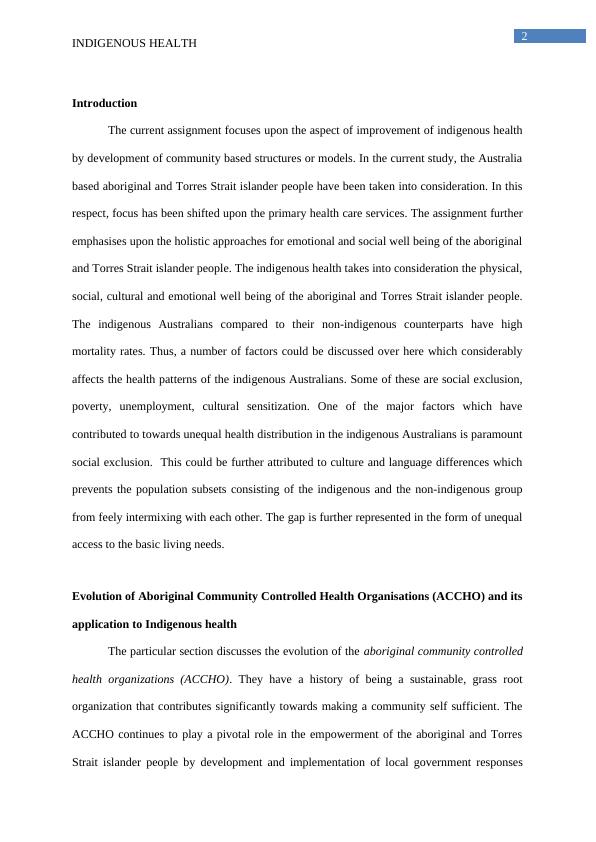Improvement of Indigenous Health through Community-Based Structures
Added on 2023-06-12
11 Pages2613 Words341 Views
Running health: INDIGENOUS HEALTH
Aboriginal and Torres Strait Islander health
Name of the student
University name
Authors’ note
Aboriginal and Torres Strait Islander health
Name of the student
University name
Authors’ note

1
INDIGENOUS HEALTH
Table of Contents
Introduction................................................................................................................................2
Evolution of Aboriginal Community Controlled Health Organisations (ACCHO) and its
application to Indigenous health................................................................................................2
Differences between Western and Indigenous understandings of health and wellbeing and
how these relate to the provision of culturally safe nursing care...............................................5
Conclusion..................................................................................................................................7
References..................................................................................................................................8
INDIGENOUS HEALTH
Table of Contents
Introduction................................................................................................................................2
Evolution of Aboriginal Community Controlled Health Organisations (ACCHO) and its
application to Indigenous health................................................................................................2
Differences between Western and Indigenous understandings of health and wellbeing and
how these relate to the provision of culturally safe nursing care...............................................5
Conclusion..................................................................................................................................7
References..................................................................................................................................8

2
INDIGENOUS HEALTH
Introduction
The current assignment focuses upon the aspect of improvement of indigenous health
by development of community based structures or models. In the current study, the Australia
based aboriginal and Torres Strait islander people have been taken into consideration. In this
respect, focus has been shifted upon the primary health care services. The assignment further
emphasises upon the holistic approaches for emotional and social well being of the aboriginal
and Torres Strait islander people. The indigenous health takes into consideration the physical,
social, cultural and emotional well being of the aboriginal and Torres Strait islander people.
The indigenous Australians compared to their non-indigenous counterparts have high
mortality rates. Thus, a number of factors could be discussed over here which considerably
affects the health patterns of the indigenous Australians. Some of these are social exclusion,
poverty, unemployment, cultural sensitization. One of the major factors which have
contributed to towards unequal health distribution in the indigenous Australians is paramount
social exclusion. This could be further attributed to culture and language differences which
prevents the population subsets consisting of the indigenous and the non-indigenous group
from feely intermixing with each other. The gap is further represented in the form of unequal
access to the basic living needs.
Evolution of Aboriginal Community Controlled Health Organisations (ACCHO) and its
application to Indigenous health
The particular section discusses the evolution of the aboriginal community controlled
health organizations (ACCHO). They have a history of being a sustainable, grass root
organization that contributes significantly towards making a community self sufficient. The
ACCHO continues to play a pivotal role in the empowerment of the aboriginal and Torres
Strait islander people by development and implementation of local government responses
INDIGENOUS HEALTH
Introduction
The current assignment focuses upon the aspect of improvement of indigenous health
by development of community based structures or models. In the current study, the Australia
based aboriginal and Torres Strait islander people have been taken into consideration. In this
respect, focus has been shifted upon the primary health care services. The assignment further
emphasises upon the holistic approaches for emotional and social well being of the aboriginal
and Torres Strait islander people. The indigenous health takes into consideration the physical,
social, cultural and emotional well being of the aboriginal and Torres Strait islander people.
The indigenous Australians compared to their non-indigenous counterparts have high
mortality rates. Thus, a number of factors could be discussed over here which considerably
affects the health patterns of the indigenous Australians. Some of these are social exclusion,
poverty, unemployment, cultural sensitization. One of the major factors which have
contributed to towards unequal health distribution in the indigenous Australians is paramount
social exclusion. This could be further attributed to culture and language differences which
prevents the population subsets consisting of the indigenous and the non-indigenous group
from feely intermixing with each other. The gap is further represented in the form of unequal
access to the basic living needs.
Evolution of Aboriginal Community Controlled Health Organisations (ACCHO) and its
application to Indigenous health
The particular section discusses the evolution of the aboriginal community controlled
health organizations (ACCHO). They have a history of being a sustainable, grass root
organization that contributes significantly towards making a community self sufficient. The
ACCHO continues to play a pivotal role in the empowerment of the aboriginal and Torres
Strait islander people by development and implementation of local government responses

3
INDIGENOUS HEALTH
(naccho.org.au, 2018). Some of these are provided in the form of effective collaboration
between hospitals and local aboriginal medical services.
The aboriginal medical services (AMS) have been developed in order to provide
improved and quality primary care services to the indigenous Australians. The primary
healthcare services provision has been discussed further with regards to the Queensland
region. Some of these have been discussed in the later sections. However, a number of other
indigenous support care frameworks have been discussed over here such as close the gap. It
is an indigenous health campaign aimed at improving responsiveness to health services for
the aboriginal and Torres islander people (humanrights.gov.au, 2018). One of the main goals
of the close the gap service was to speed up the referral processes between primary and acute
healthcare services. It was aimed at improving the life expectancy of people. The close the
gap services were aimed at increasing the control over life and physical environment of the
aboriginal and Torres islander people. The close the gaps services also focuses upon the
aspect of the inclusion of more and more indigenous health workers. This could help in
dealing with the aspect of cultural sensitization within the aboriginal and Torres Strait
islander people.
Aboriginal Medical Service (AMS) of Queensland
In the current context, the Queensland region of Australia has been taken into
consideration. One of the mentionable services active in the Queensland could be mentioned
over here which is the Northern Aboriginal Torres Strait Islander Health Alliance Limited
(NATSIHAL). It is a medical service operational in Queensland with an annual turnover of
$76,323 (Northern Aboriginal and Torres Strait Islander Health Alliance Limited, 2018). It is
a registered charity and has been implemented within the Queensland region owing to large
number of indigenous population residing in the area. It was found that one in three
INDIGENOUS HEALTH
(naccho.org.au, 2018). Some of these are provided in the form of effective collaboration
between hospitals and local aboriginal medical services.
The aboriginal medical services (AMS) have been developed in order to provide
improved and quality primary care services to the indigenous Australians. The primary
healthcare services provision has been discussed further with regards to the Queensland
region. Some of these have been discussed in the later sections. However, a number of other
indigenous support care frameworks have been discussed over here such as close the gap. It
is an indigenous health campaign aimed at improving responsiveness to health services for
the aboriginal and Torres islander people (humanrights.gov.au, 2018). One of the main goals
of the close the gap service was to speed up the referral processes between primary and acute
healthcare services. It was aimed at improving the life expectancy of people. The close the
gap services were aimed at increasing the control over life and physical environment of the
aboriginal and Torres islander people. The close the gaps services also focuses upon the
aspect of the inclusion of more and more indigenous health workers. This could help in
dealing with the aspect of cultural sensitization within the aboriginal and Torres Strait
islander people.
Aboriginal Medical Service (AMS) of Queensland
In the current context, the Queensland region of Australia has been taken into
consideration. One of the mentionable services active in the Queensland could be mentioned
over here which is the Northern Aboriginal Torres Strait Islander Health Alliance Limited
(NATSIHAL). It is a medical service operational in Queensland with an annual turnover of
$76,323 (Northern Aboriginal and Torres Strait Islander Health Alliance Limited, 2018). It is
a registered charity and has been implemented within the Queensland region owing to large
number of indigenous population residing in the area. It was found that one in three

End of preview
Want to access all the pages? Upload your documents or become a member.
Related Documents
Indigenous Culture and Health Behaviourslg...
|13
|3249
|66
Indigenous Health and Wellbeing: Closing the Gap Policy and its Significancelg...
|9
|2177
|307
Culture and Society in Public Health Assignment 2022lg...
|19
|4086
|41
Globalization and Sustainabilitylg...
|6
|1769
|78
Australian Healthcare System: Addressing Inequities for Aboriginals and Torres Strait Islanderslg...
|9
|2646
|58
Indigenous Population Health Care in Australialg...
|7
|2127
|87
